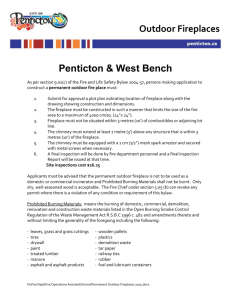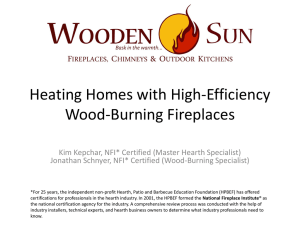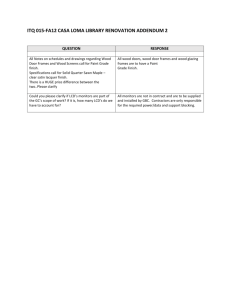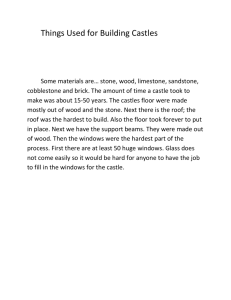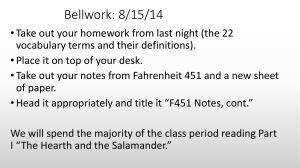Hearth, Patio & Barbecue Association Searches
advertisement
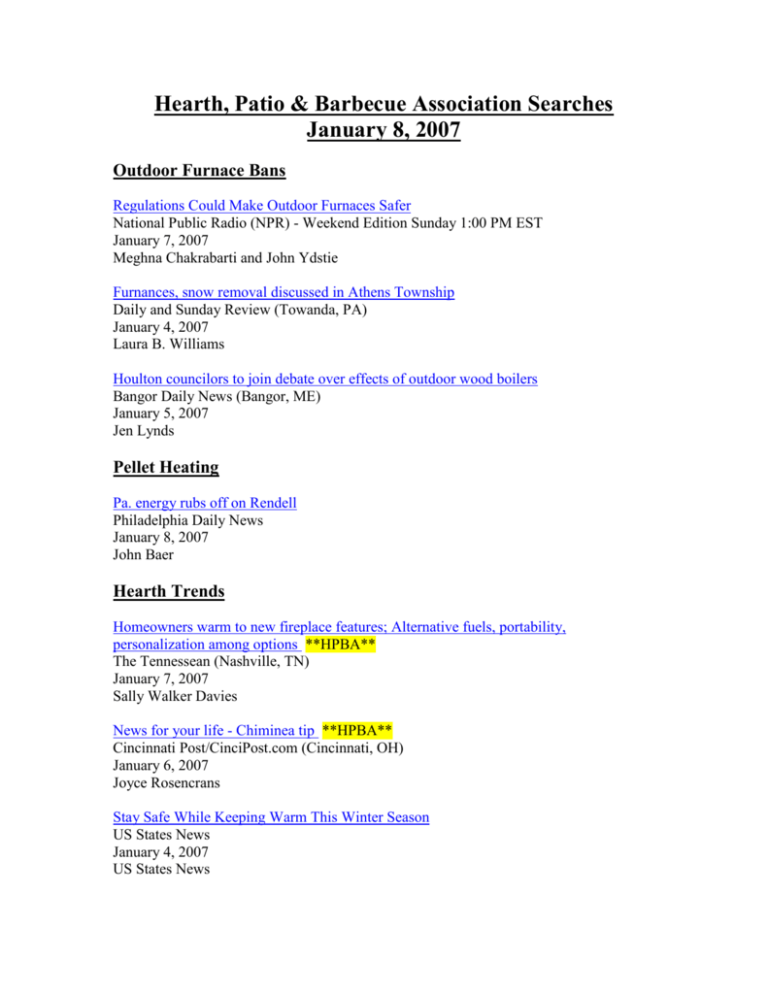
Hearth, Patio & Barbecue Association Searches January 8, 2007 Outdoor Furnace Bans Regulations Could Make Outdoor Furnaces Safer National Public Radio (NPR) - Weekend Edition Sunday 1:00 PM EST January 7, 2007 Meghna Chakrabarti and John Ydstie Furnances, snow removal discussed in Athens Township Daily and Sunday Review (Towanda, PA) January 4, 2007 Laura B. Williams Houlton councilors to join debate over effects of outdoor wood boilers Bangor Daily News (Bangor, ME) January 5, 2007 Jen Lynds Pellet Heating Pa. energy rubs off on Rendell Philadelphia Daily News January 8, 2007 John Baer Hearth Trends Homeowners warm to new fireplace features; Alternative fuels, portability, personalization among options **HPBA** The Tennessean (Nashville, TN) January 7, 2007 Sally Walker Davies News for your life - Chiminea tip **HPBA** Cincinnati Post/CinciPost.com (Cincinnati, OH) January 6, 2007 Joyce Rosencrans Stay Safe While Keeping Warm This Winter Season US States News January 4, 2007 US States News Hearth Cooking Cooking with an open hearth Citizen-Times (Asheville, NC) January 7, 2007 Rick McDaniel Regulations Could Make Outdoor Furnaces Safer National Public Radio (NPR) - Weekend Edition Sunday 1:00 PM EST January 7, 2007 Meghna Chakrabarti and John Ydstie JOHN YDSTIE, host: The warm weather has meant lower heating bills for most people this year. And some folks have found a way to bring the price down even more. They're using outdoor wood furnaces. As Meghna Chakrabarti of member station WBUR reports, smoke from the boilers is also creating a lot of friction between neighbors. MEGHNA CHAKRABARTI: Elliot Starbard(ph) lives in a old colonial house in Oakham, Massachusetts. But winter cold is seeping in through the old windows so, Starbard stepped outside to turn up the heat. Mr. ELLIOT STARBARD: How about these big ones? CHAKRABARTI: He throws big planks of wood into his outdoor wood furnace. It sits about 100 feet from his house and looks like a toolshed with a chimney on the back. Mr. STARBARD: Firebox with a water jack around it and the water gets hot from the fire. And you circulate it into your house, into your indoor central heat system. And basically you run your indoor central heat like you always did except you're no longer burning oil or gas to heat it. CHAKRABARTI: But you are burning wood. Starbard uses free scrap from a local mill, and even though the furnaces can cost more than $5,000 to install, Starbard says he's heating his home with a renewable, environmentally friendly resource. Not everyone likes the outdoor wood furnaces. Ms. SHERRY BROOKS(ph): Occasionally we'll get almost a green colored smoke and it's a real sweet plasticky sick smell. And that is horrible. CHAKRABARTI: This is Sherry Brooks. Smokes from her neighbor's outdoor wood furnace roved down the hill to Hubbardston, Massachusetts home. Brooks says at first her family tried to ignore it. Ms. BROOKS: Then when we realized the hazards, then I felt like a terrible mother because my children had been breathing it. CHAKRABARTI: So Brooks complained to her local board of health. Paul Miller advises states on air quality. He says Brooks was right to worry. Mr. PAUL MILLER (Northeast States for Coordinated Air Use Management): One normal size outdoor wood boiler that a person would buy to heat their home can put out as much air pollution in the form fine particulate matter as four idling diesel trucks. So in essence, if you have two or three of these things in your neighborhood, you have a truck stop. CHAKRABARTI: States have turned to the Environmental Protection Agency for help. EPA spokesman John Millett. Mr. JOHN MILLETT (Environmental Protection Agency): These outdoor wood fire boilers can't be cleaner. We're looking at a range of about 70 percent cleaner. CHAKRABARTI: Millett says that goal can easily be achieved with a more efficient combustion process. A group representing furnace manufacturers say they could have redesigned units on the market next spring. EPA is also giving states guidance on setback limits and the minimum chimney heights. But Sherry Brooks doesn't have to wait. After months of complaints and public hearings, the Hubbardston Board of Health asked her neighbors to shut down their outdoor wood furnace. For NPR News, I'm Meghna Chakrabarti in Boston. Furnances, snow removal discussed in Athens Township Daily and Sunday Review (Towanda, PA) January 4, 2007 Laura B. Williams The Athens Township Supervisors held their re-organizational meeting Tuesday night, and addressed both the outdoor furnace and snow removal ordinances at that meeting, supervisor and secretary Robin Smith said Wednesday. Smith said the snow removal ordinance was in need of clarification. “The way it was written was, ‘If you have a sidewalk from the house to garage, it has to be shoveled,’ and that wasn’t the intent of the ordinance,” Smith said. “Sidewalks that are used by the public are what we want shoveled,” she said. Township solicitor Jeff Osmond will be changing the wording of the ordinance to make it more clear, Smith said. Copies of the recently drafted outdoor furnace ordinance are available at the township building for interested members of the public, according to Smith. The draft was examined and discussed briefly by the supervisors on Tuesday. Written comments regarding the proposed ban on outdoor furnaces in certain areas of the township are being accepted up until the Jan. 31 meeting, according to Smith. About 10 people were at Tuesday’s meeting to talk about the proposed ban, and each took a draft home, Smith said. The ban, which will apply to all areas of the township aside from the agricultural and woodland districts, was first discussed at the November meeting. In other action, Ron Reagan was re-appointed as supervisor chairman, Maurice Fay was re-appointed as vice-chairman, Smith was re-appointed as secretary, Ruth Casterline as treasurer, and Ray Brobst as road foreman, according to Smith. Houlton councilors to join debate over effects of outdoor wood boilers Bangor Daily News (Bangor, ME) January 5, 2007 Jen Lynds Town councilors will join other public officials across the state on Monday evening when they discuss the subject of outdoor wood boilers in the community. Council Chairman Paul Cleary told his counterparts at a meeting last month that he wanted to discuss the matter after individuals in the community contacted him about the issue. "I was approached by some residents and I told them that I would bring it up," he said. The subject of outdoor wood boilers has garnered significant attention as of late. The boilers are largely unregulated, and some health and environmental groups have called for that to change. Such groups have launched campaigns for regulating wood boilers in Maine and nationwide. Both state and federal officials are struggling to figure out how to deal with wood boilers, especially in populated areas. Increasingly forced to shell out more money for fuel oil, some Mainers have turned to outdoor wood boilers as a cheaper alternative for satisfying heat and hot water needs. Outdoor boilers are wood-fired furnaces usually housed in small, shed like buildings. They feature large fireboxes surrounded by a water jacket. Hot water then flows through underground pipes to a nearby home or structure where it can be used both in the plumbing and heating system. A smoldering fire produces creosote that accumulates on the walls of the firebox. The resulting smoke that billows out can drift into nearby yards and houses. The boilers have garnered a both supporters and detractors. Some say that they contribute to pollution and that they could pose serious health risks, especially to those who suffer from respiratory problems. Health officials also are concerned that the large fireboxes could encourage some owners to burn trash, tires and other non-wood waste that can spew toxins into the air. The Maine Air Toxics Advisory Committee and the Northeast States for Coordinated Air Use Management, or NESCAUM, have called for regulation of wood boilers. Supporters argue that the smoke levels produced by the furnaces are comparable to wood stoves when the boilers are properly fueled and maintained. They also have pointed out that they do not cost a lot to operate and reduce personal dependence on foreign oil. During last month's meeting, Cleary pointed out that the town of Millinocket had recently imposed setback requirements and other restrictions to regulate the boilers and protect citizens' health. Under the Millinocket ordinance, boilers must be at least 50 feet from a neighboring home, be rated to emit no more than 27.4 grams of particulate matter per 100,000 Btu per hour, and have chimneys that are at least 24 inches above the roof line of the closest neighboring home. Local officials in Lincoln, East Millinocket, Brewer and Hampden are also considering regulating boilers.Monday's meeting begins at 6:30 p.m. Pa. energy rubs off on Rendell Philadelphia Daily News January 8, 2007 John Baer IN THE PENNSYLVANIA Farm Show food court, a place where New Year's resolutions go to die, Gov. Ed hits a roast-beef sandwich hard. With ketchup. It's not pretty. Petite, adorable 9-year-old Alisa Hardy, of Schnecksville, near Allentown, stands directly in front of His Excellency, intently looking up at the action. "Wanna bite?" asks our guv. Evidently a child of judgment and standards, Alisa declines. "No, thank you," she says. Someone hands Ed a chocolate (real ice cream) milkshake (thick enough to caulk a kitchen) and he gets Alisa to hold the lid and straw while he slugs back a couple of mouthfuls. Then he re-lids the thing and offers it to her, noting he never used the straw. Now she accepts, thanks him politely, and their encounter ends. As the guv moves off, I ask Alisa if she knows who he is. "Edward G. Rendell," she says. How things have changed. At his first show five years ago, Rendell was a candidate unknown outside southeastern counties, a city boy recognized only by viewers of Eagles post-game TV. In a suit and tie, he looked so out of place that a tour guide told him corn grows in rows. But that was then. When he opened this year's show, the 91st annual, on Saturday, he fit right in. Dressed down (for him) in a dark blue, long-sleeved, buttoned-down Ralph Lauren shirt, tan slacks, and loafers, he gave remarks at opening ceremonies then walked around greeting show-goers (500,000 are expected), posed for pictures with the Dairy Princess (17-year-old, 5-foot-10 Sarah Caldwell, of Beaver Falls) and a couple alternate princesses (hey, ya gotta have princesses) and pushed renewable energy (more on that later). Dozens of folks stop him for photos, others wave or call out. A few mention the Eagles. But nobody, not a single person, has a negative thing to say. (I've done this with lots of pols over the years and can tell you this is rare.) It's a different feel. Things are different in the food court, too. At his first show, he sacked the place. I mean, like a Visigoth entering Rome. I should mention, the food court is an arena of dietary destruction: potato doughnuts, milkshakes, French fries, maple syrup ice cream, honey ice cream, deep-fried mushrooms, deep-fried veggies, shoo-fly pie, apple dumplings, pickled eggs, mustard eggs, pork barbecue and so on. This year Ed has just the beef, a taste of shake, a bite of a chicken Parmesan sandwich and some maple syrup ice cream, which he keeps promoting. Five years ago he didn't know we had maple syrup in the state. "Well, I've learned a lot," he says, when I point out the disparity. Also, this year he's on a mission. He's big on cost-saving and cutting oil dependency, so he visits exhibits of alternative energy firms. At one, Keystone BioFuels Inc. (they make fuel out of soybeans), he hands out $2.9 million in loans and grants to push the effort. At another, Amerigreen Biofuels, he cuts a ribbon representing the opening of a new facility in Reading. At a third, he praises Southwest Windpower (they installed a windmill at the Farm Show) and flips a switch lighting a model barn to show how wind cuts costs. Now a cynic could suggest, with '08 looming, any ambitious governor wants a national policy chip or two in his or her home state, you know, just in case. But Ed's selling it. "This is an exciting show for me because of my strong belief in renewables," he says. "Just think if farmers had solar panels on their barns and houses to zero out their energy costs." He chats up West Philadelphia High School kids who built a race car that looks like a Lotus and runs on alternate fuel (150 horsepower, 55 miles to the gallon, top speed 130 mph). He pulls me into a discussion with Stan Bierly, of Millheim, near State College, who has a corn-burning stove that can heat a house for 57 hours on two bushels of kernels. Ed insists those who call alternatives a pipe dream are wrong. This stuff, he says, is "the wave of the future." He forgoes lots of the show, 24 acres under roof, with thousands of animals (cattle, sheep, horses, hogs, goats, chickens) and tons of exhibits (fruits, nuts, farm machinery). But he no doubt encounters enough nuts and barnyard behavior in his day job. I go because the show mirrors Pennsylvania: a rural state with 8 million acres of crops, farm woodlands and pastures; a state in the top 10 in production of poultry, eggs, milk, ice cream, apples, grapes, pears, potatoes, tomatoes, mushrooms, cheese, sausage and more. And the Farm Show, free through Saturday, is a great way to look at the state. Homeowners warm to new fireplace features; Alternative fuels, portability, personalization among options **HPBA** The Tennessean (Nashville, TN) January 7, 2007 Sally Walker Davies Even though their Kingston Springs home sits amid 20 acres of woods, Tom Weir and Carrie Ferguson Weir had the same debate many homeowners have when installing a fireplace: wood or gas? For the Weirs, the answer to that burning question was wood. "We're surrounded by thousands of oak trees," Tom says. "It's kind of silly not to take advantage of that." While it was a natural choice, it was also a practical one. The couple was among thousands of Nashvillians who lost power during the ice storm of January 1998, when they lived in east Nashville. "We used our gas fireplace to heat our home," says Carrie, who didn't want to risk losing heat in their more rural setting if a similar storm were to hit, especially now that the couple has a young daughter, 3-year-old Maria. Just because the Weirs' fireplace burns wood, that doesn't mean it's old-fashioned. Their 18-foot-high, personalized cast stone fireplace comes complete with a high-efficiency, motor-blower system that can heat their entire 5,000-square-foot home. "We start a fire and it gets warm upstairs right away," Tom says. "It has the capacity to heat the whole building." But wood vs. gas is only the beginning of the choices homeowners have to make with fireplaces today. New features mean more choices Gone are the days of the utilitarian fireplace or wood stove that heats a single room. Today's fireplaces include remote-control starting devices and zoned heating, realistic faux-stone mantels and surrounds,and other custom touches. "I see the traditional fireplace changing," says Phillip Pardo of Pardo Hearth Designs in Cheatham County. "We're moving into a world with more efficient products, like a wood stove that sits in the house and is more like a furnace; it's a workhorse." Other efficient products include masonry fireplaces, which hold heat for long periods of time after the fire is extinguished, and wood pellets or corn as fuel for freestanding stoves. "Output blowers can be put on any of the units we sell," says Zach Watson, manager of Embers, a 30-year-old family business in Brentwood. "You can also run heat zones — you can run a duct off the fireplace into another room." Electric fireplaces have come a long way, with sizes ranging from 21 inches to as large as 42 inches. Their greatest advantage is portability, as they are vent-free and require only an electrical outlet to install, with features that include mantels and cabinets in attractive finishes of wood and faux stone. The most popular electric fireplaces today, however, are so-called portrait fireplaces that hang on the wall at about the height one would hang a painting. "A lot of people are moving fireplaces up higher to give it a different look," Watson says. "They're popular because they don't take up any space," Pardo adds. "There's one that mounts in a corner that includes a shelf, which is great for master bedroom and bathroom-type areas." With more contemporary designs and the ability to use a variety of fuels, free-standing stoves have come back into style. Traditionally, free-standing stoves burned wood, oil or coal; now, they are fueled by natural gas, wood pellets or even dried corn. Wood pellets are made of compressed sawdust and contained in a hopper that feeds automatically into a stove. The pellets are clean-burning as well as economical, as is dried corn, which is sold at many area feed stores and is the least expensive heating option for free-standing stoves. A few of Pardo's clients have recently installed fireplaces that use ethanol (made from corn) as a fuel source. A reservoir is filled with the ethanol, and the fireplace is controlled with a small burner. "You still have a moisture issue, but you don't have burnt gases left in that fire," Pardo says. "The price is a hefty price for a small unit. It's contemporary, unique — you're paying for the design of the product, and the ethanol is not cheap." Pardo heats his own home, a 2,500-square-foot cabin, with a direct-vent fireplace. "I have 20-foot-tall ceilings in my cabin," Pardo says. "The fireplace is on a remote thermostat, is gas operated and has blowers." Cast stone offers style at lower cost Maximizing a fireplace's heat isn't the only technological advance. Cast stone fireplace surrounds are also very popular, in new construction as well as when updating existing fireplaces. A masonry product, cast stone is made of concrete but can be made to look like limestone, sandstone, slate and other natural building stones. "It is the look of actual stone, but the floor won't need the reinforcement," Watson says. "And it's a fraction of the price" of real stone. When the Weirs built their fireplace in a space that housed a huge living room window, they worked with Pardo on the design, which is a beautiful rough-hewn cast stone. Carrie thought her husband was teasing her when he told her the stoneworkwasn't real stone. "She thought I was playing a joke on her," says Tom, who watched in amusement as his wife dashed off to verify his claim with the installers. "It is amazing," she says, "fabulously real looking." Personalization adds to coziness The Weirs both work primarily out of their home, so creating a personalized atmosphere was important to them when they moved in five years ago. A friend, artist Jacques Dergee, re-created a Diego Rivera mural in their living room. Paintings by Tom and his grandmother fill the home, and Tom built what Carrie calls "funky and folk-ish" bookshelves. To add to their home's distinctive character, Pardo suggested that the Weirs personalize the stonework. Because they refer to their home and surrounding area as Weir Woods, the Weirs considered a double W but eventually returned to the forest for inspiration. "We went out into the yard," where there were nice fallen leaves — beech, oak and maple, Carrie says. "So I scanned them and sent the JPEGs to the stone cutter." The result looks like a puzzle, with the leaf cutouts attached to the stonework and placed to match the outline of the original cut. "The beauty of it is that it is very subtle, and we were able to pick leaves just outside of our home," Carrie says. "It kind of echoes that we're surrounded by the woods," Tom says. "It's a nice aesthetic touch." Maintenance Tips: • Have the chimney inspected annually and cleaned as necessary by a professional chimney sweep to ensure that it's clear of obstructions and creosote. • Install a cap at the top of the chimney to avoid the possibility that animals or debris can block the chimney. • Install smoke and carbon monoxide detectors. Make sure the batteries work. • Keep a fire extinguisher on hand. • Keep furniture, books, newspapers and other flammable materials at least two feet away from the fireplace. Source: Hearth, Patio & Barbecue Association (www.hpba.org) News for your life - Chiminea tip **HPBA** Cincinnati Post/CinciPost.com (Cincinnati, OH) January 6, 2007 Joyce Rosencrans Select a stand for rain gear A rainy Friday brought out the umbrellas. It reminded me how handy it is for every home to have an umbrella stand or two. The casual one pictured above includes a coat rack. I don't care for the design, but it would be practical in a mudroom or hallway leading to the garage. In a more formal front entrance, a simple can style is better. The right umbrella stand in a foyer can look classy and interesting if supporting a handsome collection of stick umbrellas with curved cane handles and a few fancy walking sticks. A shop in Waynesville, Ohio, had just the umbrella stand I needed years ago - a simple brass can, probably late-Victorian era. It was undented and not too shiny. I'd just returned from my first trip to England, where Portobello Road antiques market had yielded some 18th century brass candlesticks and 19th century rail-car lamps from Britain's Great Northern Railroad. The brass umbrella stand would go-with and be just fine for holding the long black umbrella my husband bought at Liberty's in London. (Naturally, it was drizzling the day we watched the changing of the guard at Buckingham Palace.) Even now, the umbrella stand's small lion heads with brass rings on either side make me think of the Queen and that lovely rainy day. With a little brass polish and elbow grease twice a year, the umbrella stand still softly shines. And I don't care that shelter magazines insist that brass is "out." Brass, in moderation, is like jewelry in a room, especially for cream walls and warm colors. In a pale blue room, I prefer silver accents. A brushed nickel finish might be more contemporary, but give me traditional shine. Another thing about umbrella can styles. They're dandy places for hiding pet toys, especially balls that might otherwise be hazardous if left on the floor or stairs. Corral them all in the depths of an umbrella stand. If you're in the market for some new bumbershoots, Scripps' Fine Living Network maintains that Teflon-coated nylon is the most waterproof umbrella material. Cotton looks great but becomes heavy with water and dries slowly. Storage boxes Some people hang on to shoe boxes for storage. A cheerful-looking alternative is the $20 "Hotel" shoe box by Pure Nomade (each cardboard cubbyhole easy to assemble). Stack some to hold small office supplies or cosmetics. The "Hotel" comes in 16 patterns and colors, including candy pink and pistachio, which have a linen texture; the wild patterns are glossy. The novel shapes were created by a Danish industrial design firm, but they can be ordered through New York's YoyaMart, at www.yoyashop.com or (212) 2425511. Chiminea tip During this warm winter, more people are enjoying outdoor firepits and appliances. Chimineas are usually clay, each with a chimney to draw fresh air into the fire and direct smoke up and away. Chimineas also safely enclose the fire, but the Hearth, Patio and Barbecue Association does not recommend that chimineas be used on wood decks. Stay Safe While Keeping Warm This Winter Season US States News January 4, 2007 US States News DATELINE: RICHMOND, Va. The Virginia Department of Housing and Community Development issued the following news release: In 2003, heating equipment was involved in more than 53,000 U.S. home fires, 260 deaths, 1,260 injuries and $494 million in direct property damage, according to a report from the National Fire Protection Association. From January through November 2006 in Virginia, approximately 15 percent of home fires were related to heating sources. With more families turning toward alternative sources of home heating to save on high fuel costs, the use of wood burning stoves, space heaters, and more has increased. With it, the risk of fire and carbon monoxide poisoning has also increased. The Virginia State Fire Marshal's Office and the Virginia Department of Fire Programs urge citizens to be aware of the dangers and take precautions for safety this year. "While the weather has been relatively mild so far, the winter season is just beginning in Virginia and the time to take precautions is now," said State Fire Marshal Ed Altizer. "It is important to prepare now for keeping your home warm and safe this season, being ready in case you need to use a generator, and taking the time now to protect yourself and your family from potential carbon monoxide poisoning." Winter Heating and Carbon Monoxide Safety Tips: When purchasing a new space heater, smoke detector, or carbon monoxide alarm, make sure it carries the mark of an independent testing laboratory; * Have fuel-burning heating equipment (fireplaces, furnaces, water heaters, wood and coal stoves, space, or portable heaters) and chimneys inspected by a professional each year; * Ensure your fireplace has a sturdy screen to prevent spark fires, allow fireplace and wood stove ashes to cool before disposing in a metal container; * Use only wood that is properly seasoned to reduce creosote build-up; * Ensure that gas-fueled heating devices are installed with the proper ventilation; when using a fireplace, open the flue; * Have fixed space heater units professionally installed or inspected by a qualified technician, and maintain a 36-inch clearance between space heaters and anything flammable; * Turn off portable space heaters when sleeping or leaving the room; * Closely watch children and pets in rooms with heating equipment, and keep them safely away; * Never use your oven or grill to heat your home; * Install a carbon monoxide (CO) alarm in central location outside of each sleeping area to provide early warning of accumulating CO; and * Test smoke and CO alarms at least once per month. Generator Safety: * Regardless of whether the garage doors are open, do not run a vehicle, generator, or other fueled engine or motor indoors. Generators should be operated in well-ventilated locations outdoors where exhaust fumes cannot enter the home through windows, doors, or other openings; * Turn generators off and let them cool down before refueling; * Never store fuel for your generator indoors; store them away from any fuel burning appliance such as gas water heaters, etc.; * Plug appliances directly into generators, or use heavy duty outdoor-rated extension cords that are free of cuts or tears. Use extension cords with three prongs and a grounding pin. Do not power the house wiring by plugging the generator into a wall outlet; * If you must connect the generator to the house wiring to power appliances, have a qualified electrician install a properly rated transfer switch in accordance with the National Electric Code and all applicable state and local electrical codes. "These are the leading months for home fires and we all need to take extra care to protect our families and loved ones," says W.G. "Billy" Shelton Jr., executive director of VDFP. "Loss of life and property resulting from heating fires can be prevented by being able to identify potential hazards and following these simple safety tips." The Virginia State Fire Marshal's Office is administered by the Virginia Department of Housing and Community Development (DHCD). DHCD regulates Virginia's building and fire codes, provides training and certification for building officials, and invests more than $100 million each year into housing and community development projects throughout the state. DHCD is committed to creating safe, affordable, and prosperous communities to live, work and do business in Virginia. Visit the DHCD Web site at: www.dhcd.virginia.gov. The Virginia Department of Fire Programs (VDFP) provides fire and emergency services support to communities throughout Virginia in the areas of professional development, public fire and life safety education, technical assistance, research, advocacy, operational support and funding. For more information on home fire safety, please visit the VDFP website at www.vafire.com or contact your local fire department. For more information on fire safety education, visit the Virginia Department of Fire Programs Web site at: www.vafire.com, or contact your local fire department. Contact: Mark Buff, 804/3710220, 804/396-0542, mark.buff@vdfp.virginia.gov; Hollie S. Cammarasana, 804/371-7006, 804/519-3540, hollie.cammarasana@dhcd.virginia.gov. Cooking with an open hearth Citizen-Times (Asheville, NC) January 7, 2007 Rick McDaniel ASHEVILLE - When the early settlers found the piece of the Appalachians they wanted to claim, one of their first priorities was finding rocks to build a fireplace. The stone hearths that were part of every log cabin were the main source of hot meals for Appalachian families from Colonial times until wood cook stoves began to appear in the latter part of the 19th century. "They cooked everything on the open hearth," said David Tate, site manager for the Vance Birthplace State Historic Site. "They roasted chickens and other fowl by trussing them up and hanging them from a bar in the back of the fireplace. They also cooked fish by tying them on wood planks and leaning them up against the side of the hearth." Hearth anatomy The typical Appalachian cabin had a hearth made from stone found on the property. Chimneys were mostly made from the same stone, although some affluent mountaineers such as the Vance family made chimneys out of site-made brick. Inside the chimney, an iron rod known as the "back bar" provided a place for hanging pots. In many cabins the same fireplace served as the sole source of heat as well as for cooking. As the family grew and the cabins gained rooms, the ideal situation was to add a second fireplace for the roaring fire necessary for heating and allow the original fireplace to hold the cooking fire, which was allowed to burn down to the hot coals needed for roasting and baking. Tate said. Tools of the trade Kitchen tools for open hearth cooking varied widely depending on the family's wealth. "Pots, pans, skillets and Dutch ovens were mostly made of cast iron," said food historian Barbara Swell of Asheville, who has written a series of books on traditional mountain cooking and teaches classes on open hearth and woodstove cooking. "Pots were hung from the back bar on hooks, and the skillets and pans had little spindly legs to allow coals to be placed under them." As in modern times, all sorts of kitchen gadgets were available to make cooking easier. "We have a potato roaster, a five-prong iron stand that you could pierce five potatoes and set them in the coals to roast," Tate said. "There were also toasters that worked the same way." Other necessities for open hearth cooking were tongs for repositioning hot logs and longhandled shovels for banking coals around Dutch ovens. Iron hooks of various lengths called trammels were used to suspend pots at different heights above the fire to regulate cooking temperature. What they cooked "Soup beans, chicken and dumplings and wild game were some of the iconic foods of the Appalachians," said Mark F. Sohn, food section editor for "The Encyclopedia of Appalachia" and author of "Appalachian Home Cooking: History, Culture, and Recipes." "Cornbread was another favorite. They would make a stiff dough, roll it in the palm of their hand and cook it directly in the ashes." As the industrial age brought new technologies like wood and coal fired cook stoves, the cuisine of Appalachia began to become more sophisticated, Sohn said. "One example is oyster casserole, which became common in Appalachia after the railroads brought oysters to the mountains in the early years of the 20th century," Sohn said. No lights, no problem Cooking on campfires and hearths is still a useful skill, according to Swell. "You can cook everything from soup to bread right in your fireplace," she said. "And if the lights go out, you still have a hot meal." For modern cooks, Swell advises starting with a bed of ash in the fireplace, then building a good fire out of hardwood. "After it burns down for about two hours, you can throw foil-wrapped potatoes in the coals, or if you have a Dutch oven with a lid, you can even make biscuits." Rick McDaniel of Asheville is a freelance writer. E-mail him at southerncooking@charter.net. Dutch Oven Buttermilk Biscuits 2 cups self-rising flour 5 tablespoons unsalted butter Buttermilk to make a soft dough (fresh preferred over powdered) Work the butter into the flour, and add enough buttermilk to make a soft dough that you can handle. Knead the dough a few times so it holds together in a ball. Roll out on a lightly floured surface about 1 inch thick (use all purpose and not self rising flour for rolling!) Place on a buttered baking sheet and bake in a preheated 450 oven for about 15 minutes until lightly browned. Or if baking in a campfire, place the biscuits in the bottom of a well buttered preheated Dutch oven. Place coals on top and on the bottom and bake about 15 minutes away from direct flame. Recipe courtesy of Barbara Swell Campfire Meatloaf in an Onion Slice through one side of an onion all the way through. Take out the insides leaving about 2 or 3 layers of onion, depending on thickness. You can do this about 3 times if you have a large onion. Fill each onion with a blob of meatloaf (recipe below), salmon patty, veggie burger, chopped veggies mixed with breadcrumbs or anything you can think of. Wrap in a couple layers of foil and throw next to the coals of a hot fire. Bake until insides are done and hopefully, the onion is caramelized but not burnt. Meatloaf You can use any kind of ground lean meat. Drained canned salmon will work too. Chop up the leftover insides of the onions, and add diced pepper, any color. Mix in an egg and throw in a handful of bread or cracker crumbs and some chopped fresh herbs, and pepper. Most non-organic meats are already salted, so salt to taste when cooked. Combine well and proceed with onion stuffing. Recipe courtesy of Barbara Swell

